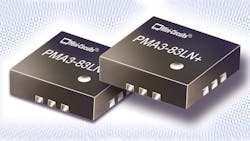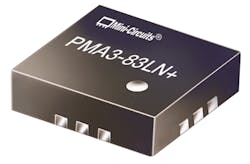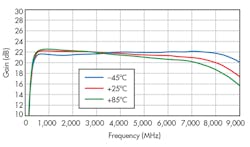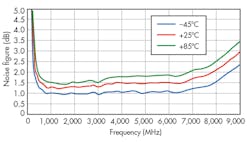Amplifier Trims Noise from 0.5 to 8.0 GHz
This file type includes high resolution graphics and schematics when applicable.
Amplifiers with low noise figures are usually relatively narrow in bandwidth, achieving the excellent noise performance through precise impedance matching for a given frequency range. The model PMA3-83LN+ low-noise amplifier (LNA) from Mini-Circuits breaks with tradition by providing impressive noise-figure performance of 1.3 dB from 0.5 to 8 GHz.
Admittedly, while commercial amplifiers are available with sub-1-dB noise figures, they typically lack the bandwidth of the PMA3-83LN+. The wide bandwidth, in addition to the amplifier’s generous small-signal gain and respectable output power at 1-dB compression, positions this amplifier as a strong candidate for broadband front-end receiver applications through 8 GHz, as well as a single solution for a wide range of more narrowband applications through that upper frequency limit.
The broad frequency range accompanied by such a low noise figure makes this amplifier an attractive fit for a wide range of applications in commercial, industrial, military, and test-and instrumentation markets. In addition to serving a host of different radio receivers throughout that frequency range, the LNA’s low noise figure can help achieve improved performance in Global Positioning System (GPS) satellite receivers operating at 1.575 GHz, as well as in S- and C-band satellite-communications (satcom) radios.
For example, using just a portion of the LNA’s total bandwidth, this amplifier can support a variety of octave-wide 2-to-4-GHz S-band applications. The amplifier can help miniaturize S-band radar receivers without sacrificing overall performance. It can be used in weather radar applications across that frequency range, as well as in maritime radio systems. The amplifier can also find use in the many satcom systems operating at S-band frequencies, including in mobile satellite services (MSS) systems.
In addition, S-band frequencies are increasingly used in medical applications, such as medical linear accelerators for radiation treatment. Of course, the amplifier can also be used for multiple-band applications, which might otherwise require multiple LNAs to achieve the required combination of gain and noise figure.
The model PMA3-83LN+ LNA (Fig. 1) is a monolithic-microwave-integrated-circuit (MMIC) amplifier based on a GaAs pseudomorphic high electron mobility transistor (pHEMT) semiconductor technology. It is housed in a low-profile 12-lead (MCLP) package (most of those 12 pins are not used or used to enhance ground connections) that is well matched to 50 Ω to maintain the low noise figure and flat gain across the frequency range.
The small size of this housing makes it convenient for installation on densely packed printed circuit boards (PCBs). The package also provides a reliable thermal path for any heat generated by the amplifier within it: With the package’s paddle connected to ground, the amplifier achieves reliable electrical and thermal connections to a PCB. The package measures just 3.00 × 3.00 × 0.89 mm.
As with most LNAs, the amplifier has been characterized for noise, gain, and other parameters at room temperature (+25°C), and it performs well under those environmentally controlled conditions. The LNA operates on a single +5 or +6 VDC supply, with little compromise in performance based on the choice of bias voltage. When tested with a bias voltage of +5 VDC, the noise figure is typically 1.5 dB at 0.5 GHz, rising to typically 2.06 dB at 8 GHz. The gain is typically 21 dB at 0.5 GHz under the same bias conditions, dropping to 19 dB at 8 GHz. At +5 VDC, the output power at 1-dB compression is typically +19.7 dBm at 0.5 GHz and +17.7 dBm at 8 GHz.
Even with the low operating voltage, the tiny amplifier is capable of quite respectable output power at 3-dB compression (IP3), of +37 dBm at 2 GHz and +29.3 dBm at the 8-GHz upper band edge. The tiny LNA also registers outstanding input and output return-loss performance; typical input return loss is 14 dB at 0.5 GHz, dropping to 8 dB at 8.0 GHz, and typical output return loss is 12.8 dB at 0.5 GHz, falling to 10.7 dB at 8.0 GHz, with all return loss values measured for a bias voltage of +5 VDC. At room temperature, the amplifier maintains flat gain of ±0.7 dB from 0.5 to 7.0 GHz and within ±1.1 dB across the full bandwidth from 0.5 to 8.0 GHz.
When the bias voltage is increased to +6 VDC, the noise figure remains consistent, with a slight increase in gain and an expected increase in output power at the higher voltage. For example, the model PMA3-83LN+ exhibits noise figure of typically 1.53 dB at 0.5 GHz and 2.06 dB at 8 GHz. At +6 VDC, the gain is typically 21.7 dB at 0.5 GHz and 19.8 dB at 8 GHz. When operating at the higher bias voltage, the output power at 1-dB compression is typically +22.2 dBm at 0.5 GHz and +18.6 dBm at 8 GHz. The IP3 performance is somewhat higher at the higher bias voltage, reaching +34.0 dBm at 0.5 GHz and +29.3 dBm at the LNA’s upper band edge frequency of 8 GHz.
Of course, this overall solid performance at room temperature is just part of the story for the model PMA3-83LN+, which performs admirably when subjected to changes in temperature. The amplifier is specified for a wide operating temperature range of -40 to +85°C, and it handles the changes in temperature with only slight variations in performance. When full-band gain was measured at room temperature and at the extremes of the temperature range, as expected, the gain remained high at -40°C throughout the amplifier’s bandwidth. But at +85°C, the gain response, albeit somewhat lower than at room temperature, actually tracked the room-temperature gain response through 8 GHz (Fig. 2).
Similarly, the amplifier’s noise figure is very well controlled with temperature across the full frequency range (Fig. 3). When tested with a bias voltage of +6 VDC, the LNA exhibited the expected drop in noise figure at the lowest operating temperature; however, only a slight increase in noise figure was noted at the highest operating temperature, closely tracking the noise-figure response with frequency at room temperature. Likewise, the output IP3 performance remains steady with temperature, especially above about 3 GHz.
In truth, the model PMA3-83LN+ LNA does not match the extremely low noise figures of the best (and more expensive) LNAs on the market with noise figures of 0.5 dB or better at these frequencies. But it is nevertheless a versatile performer, as evidenced by its combination of high gain, low noise, and respectably output power—all of which remain flat with frequency and consistent with temperature.
The amplifier typically draws 85 mA current at +6 VDC and 63 mA at +5 VDC. It is qualified to electrostatic-discharge (ESD) rating per the human body model (HBM) of Class 1A (250 to <500 V) in accordance with the ANSI/ESD STM 5.1-2001 standard, as well as an ESD rating per the machine model (MM) Class M1 per the ANSI/ESD STM5.2-1999 standard. It also features a moisture sensitivity level (MSL) rating of MSL1 per the IPC/JEDEC J-STD-020D standard. An evaluation board (model TB-830+) is available for designers wishing the verify performance in their own laboratories.
Mini-Circuits, P.O. Box 350166, Brooklyn, NY 11235-0003; (718) 934-4500
This file type includes high resolution graphics and schematics when applicable.
About the Author
Jack Browne
Technical Contributor
Jack Browne, Technical Contributor, has worked in technical publishing for over 30 years. He managed the content and production of three technical journals while at the American Institute of Physics, including Medical Physics and the Journal of Vacuum Science & Technology. He has been a Publisher and Editor for Penton Media, started the firm’s Wireless Symposium & Exhibition trade show in 1993, and currently serves as Technical Contributor for that company's Microwaves & RF magazine. Browne, who holds a BS in Mathematics from City College of New York and BA degrees in English and Philosophy from Fordham University, is a member of the IEEE.




